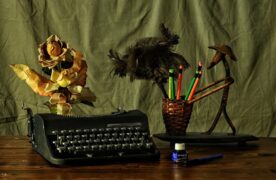In “The Castle”, Richard Mosse deploys hi-tech thermographic cameras of the kind associated with stealth surveillance by the military. He uses the technology to record moments of life in refugee camps and border crossings along the migration routes into Europe from neighbouring continents.

Sean Sheehan
The site for an emergency shelter, a disused airport in Berlin, takes on a disturbing resonance. Tempelhof Airport was designed by Ernst Sagebiel and built in 1934 as part of Hitler’s visionary plan for the new Nazi Germania that would emerge after victory in World War II.
The stringent geometry of the airport’s interior design is visible Mosse’s photograph, taken in 2016, captures and the equally symmetrical arrangement of the temporary ‘homes’ for refugees.
The viewer is invited to peer down voyeuristically into the numbered, open-top cubicles. We see human figures going about their frugal business, their belongings tied up in plastic bags.

Another photograph, of the Moira camp on Lesbos in Greece, was taken in January 2017 when the temperature fell and snow descended.
Mosse notes how hard it was for those living there in tents and that three men died in their sleep, their deaths linked to carbon monoxide poisoning from makeshift heaters.
In the distance can be seen the coastline of Turkey from where human traffickers ‘corral groups of refugees before launching them covertly across the Aegean Sea for European shores. In one part of the photograph, shown here, we see a long line of them queuing, hoodies their only protection from the cold.
The photographs in their ghostly depictions of powerlessness do not allow for any edifying empathy. Selfhood can be surmised and attributed from their stilled procession but the refugees are anonymous.
They are as externalized, devoid of interiority, as characters in a Brecht drama; as disinherited and destitute as figures from a Beckett text. There is no comfort here for the humanist. Look closer at the faces of those queuing at Moira and you’re confronted with their reduction to the spectral. The camp is now grossly overcrowded and conditions there are grim in the extreme.
Nobukho Nqaba, born in South Africa as apartheid was coming to an end, grew up in the Eastern Cape region while her mother worked nearly a thousand miles away in Cape Town.

When possible, her mother would make the long journey home carrying those Chinese-made, check-patterned plastic mesh bags that signify the low-income traveller. In school holidays, with time to visit her mother, her father would use this kind of bag to pack what Nqaba needed.
The bags, called ‘unomgcana’ in the Xhosa language, became not only a marker of migration but for Nqaaba ‘my companion throughout my childhood life and journeys. It has been my comfort and my home’. Some of her photographs are included in an exciting new photobook, “Africa state of mind”.
“The Castle” by Richard Mosse is published by MACK
“Africa state of mind”.edited by Ekow Eshun is published by Thames and Hudson
(Photos supplied by the publisher)












.jpg)












